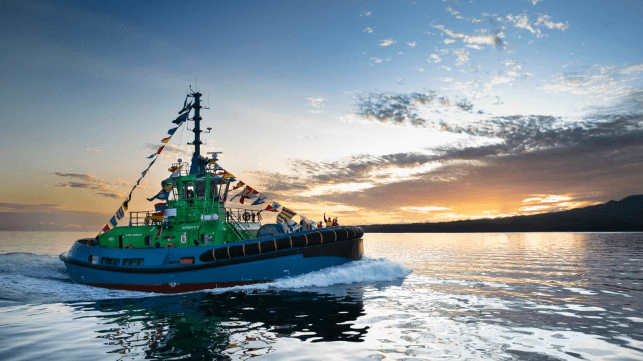Auckland Welcomes First-of-a-Kind Electric Harbor Tug

Ports of Auckland has taken delivery of its groundbreaking all-electric tug, Sparky, which arrived in New Zealand earlier this week.
Sparky is the world's first full-sized harbor tug. The 25-meter workboat has 70 tonnes of bollard pull - the same as the port's strongest diesel tugboat. It will be able to do three to four shipping moves on a full charge, or about three to four hours of work. A fast charge will take about two hours.
"Back in 2016, when we first pitched the idea for a fully electric tug, we were told we were dreaming. To see Sparky in real life like this is that dream coming true."
"Due to the pandemic, we were unable to travel so we've been watching the build, launch and initial sea trials online. To welcome her to T?maki Makaurau now is incredible," said Allan D'Souza, GM Marine and Multi Cargo Operations at Ports of Auckland. "You'll be able to spot Sparky on the water as her superstructure is painted bright green, unlike our diesel tugs. What you won't notice is noise or smoke."
This unique vessel is in a class of its own, but not for long: two more are under construction at Damen's Song Cam Shipyard in Vietnam, according to the port (below).
So good to see Sparky finished - and two more 'Sparkies' under construction in the background! https://t.co/pOVnW0bEZu
— Ports of Auckland (@AKLPort) April 7, 2022
The port is going high-tech with its tug fleet, but it is taking a step back on terminal authomation. On June 8, it announced that it will be canceling a long-delayed project to automate its Ferguson Container Terminal, New Zealand's largest, and return it to fully manual operations. The project is two years behind schedule, and independent experts advised the port that it would be hard to predict how long it would take - or how much it might cost - to get it running. In the meantime, the project development and testing work would continue to disrupt operations for customers, the port said.

that matters most
Get the latest maritime news delivered to your inbox daily.
"Despite the best efforts of our team and our supplier, the project is experiencing continuing delays to full terminal roll out, the system is not performing to expectations, and we do not have confidence in the projected timeline or cost to completion," said board chair Jan Dawson. "With these uncertainties and the need to transform the port's performance, the board has determined the best course of action is to cease automation of the container terminal."
The port will write off about $42 million in expenses for the automation guidance system and software. The related investments it has made in new wharfage and cranes will still be of use, CEO Roger Gray said in a statement.
